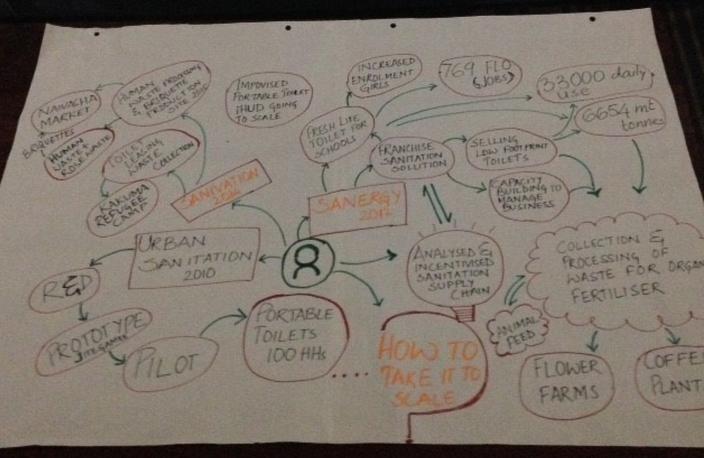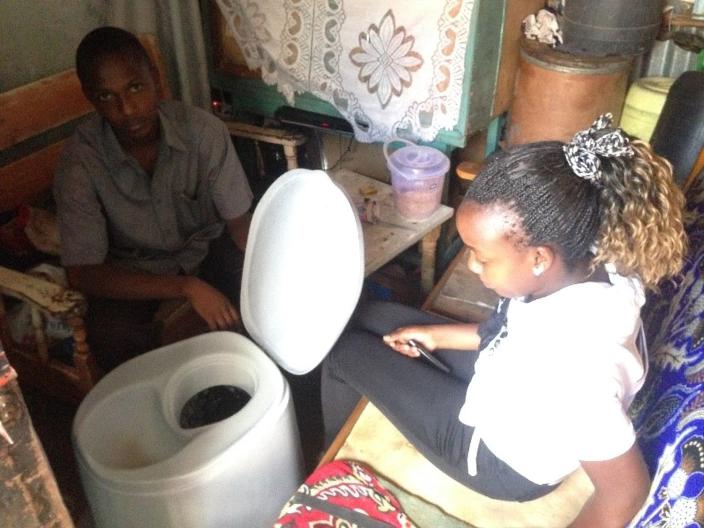As I was scanning through my archive to find a photo of the first water ATM, I came across this presentation that I did as Country Director for a Regional Leadership meeting on Innovations, in October 2015. This is one such Oxfam Kenya initiative that I am truly proud of, that has self-propelled and has its own life. I think it is important that the new entrants to Oxfam know about such initiatives, learn and take pride in the work we do and also for those who have been part of this initiative at varied points to see where the journey has progressed.
Sipping through my cup of tea, I decide to refresh my memory to narrate the pictorial representation I had done then. Well not too difficult I guess…

Oxfam had decided in 2008/09 that it would focus on urban poverty as a strategic direction. After a robust context analysis, we decided that we should focus on two thematic areas- governance and livelihoods. Water and sanitation was part of the livelihood programming, you might wonder why? Well let me keep you guessing…So we started our Nairobi Urban Sanitation programme in 2010.
‘Flying toilets’ are common for households unable to pay for using the toilets owned by private owners in the informal settlement. Flying toilets in the simplest form is to just use one of the utensils/pots to release, store the human waste in the house, pack it in a polythene bag and just throw it off in the evening…if you happen to be walking on the dark streets of the informal settlement and it lands on your head, consider it blessing and move ahead. This was a more common practice for women and girls.
Given the health hazard of such a practice and the household’s inability to pay, Brian McSorley our WASH advisor got interested in the subject and got to work on a prototype. An engineer at heart, one could see his table with reams of papers with various designs for the portable toilet which would then get translated on soft copies. After a lot of research and development (R&D) we finalised the prototype and called it ‘Jitegemee’ which was a mobile toilet in the design of a container/bucket. Every effort from Brian to get a Kenyan plastic supplier interested in producing the prototype failed, (he worked with Kentainers for atleast 6 months! and it was going nowhere) and finally Brian decided to reach out to producers in India. We piloted about 100 of the Jitegemee toilets in the informal settlements to field test and get feedback on its functionality.
Women had highlighted lack of sanitation as their highest priority and were the most positive about the project (this was a gender focused project). Men were less inclined to use toilets but reported that they liked the initiative because their wives and children liked it. We also got very interesting feedback- some said that they would like to use it for storing maize, some said for important documents as they felt that the toilet was well built and would not be infested by the rats.
Brian in his own words said, ‘Me as an engineer designing a toilet, with no community consultation or engagement, was so obviously, a limiting factor and a shortfall’. Perhaps fortunately, despite this, it wasn’t a failure. This project was an outstanding example of a strong R&D with lot of useful learning.
Philippa Crosland-Taylor, the then Country Director, linked up Brian with her mate Helena Wayth (ex-senior L’Oreal marketing manager & Unilever). You might wonder what would a person dealing with L’Oreal perfumes and cosmetics got to do with the poo? Helena had real life practical experience from the commercial world on launching new products and brought in a totally different perspective. We hired TNS-RMS, a leading marketing agency as a technical advisor to help with the pilot. The technical detail and professionalism they brought to designing consumer surveys (we would call that focus group discussions) was a real eye opener, as was their statistically significant analysis of results. Helena would often joke how much more important poo was than perfume. Her motivation (for taking the salary cut) was that the world doesn’t need another perfume or cosmetics but it does need a solution to the sanitation crisis.
The reality was production in India and shipping was costing us immensely. Brian and team had to work again, this time they were more careful with the design elements, to segregate urine and faeces so that it would arrest the issues around the stench. It would also then be helpful in developing two value chains- organic fertilizer for the farms and animal feed.
The worry was how to scale up the pilot? Well if you asked Brian even today, he would say that ‘we are still in pilot’ and this is where I guess we need to be realistic. A pilot including R&D that has taken more than 5 years needs moral support from the leadership, flexibility, resources and most importantly perseverance. Organisations like ours hardly have the time, patience, luxury to incubate and allow the growth of such ideas for this long. Oxfam partnered with Sanergy in 2012. - I would say this was the best thing that we could have done and am sure Brian is proud of it too- knowing our limitation and letting go/ losing control of what was ‘Brian’s baby’ to an organisation with people better qualified to take the idea forward- influencing them to buy in and run with it.
Sanergy has a franchise model that works to find sanitation solutions. Oxfam thought of analysing and incentivising the sanitation supply chain in partnership with Sanergy. Oxfam got funding to pilot ‘Freshlife’ toilet in schools. This led to increased enrolment of girls but also created jobs, collection and value addition of the human waste. Unemployed youth were employed to collect waste from households and would be paid a token amount by the household. The waste collected, would, then move into the next level of value addition-organic fertilizer. This fertilizer was being sent to the flower farms in Naivasha, to the coffee plantation in Nyeri and they had plans to send it to the tea gardens as well. They also produced animal feed. Black soldiers- a type of insect is allowed to feed on the fresh faeces and its pupae are very rich in protein and beneficial for the animals as a feed. Just before I finish off on this trail of thought, the pupae smell like chocolate more precisely nice nutty chocolate. So, next time you grab your chocolate at the counter, please read the ingredients carefully, who knows what’s in there!
In 2015, we had finalised our mobile toilet model and now we called it iHUD. Jitegemee, even though it meant ‘sustain yourself’ apparently had a political connotation too. Sanergy is now producing the iHUD in Kenya, employing distributors to sell the mobile toilets. There are still some teething problems with the iHUD on cost and complexities of production and servicing but also the fact that it is not nestable or stackable causes a challenge for humanitarian use. Sanergy is quite keen on addressing those issues and has recently contacted Oxfam for funding. By the way in line with their branding, Sanergy now sells the iHUD as ‘Freshfit’ toilets complementing their ‘Freshlife’ franchise.

This is quite a clever English and Swahili play on words – “fit” in that it is small and easily fits into a tiny dwelling and their sales pitch “Niko fiti” – I’m cool! This is where they have been very smart in professionalising and changing the perception around sanitation. In 2010, we tried to involve existing sanitation vendors to collect waste from people’s houses but this was totally unacceptable to customers who viewed these people as dirty and untrustworthy. Sanergy has managed to turn it into a respectable profession through uniforms, training, focusing on customer service so people want to work in the sanitation industry. Today as per Sanergy’s data (from their website) they have 1691 active fresh life toilets in the urban informal settlement, 50,000 daily uses from community members now accessing affordable hygienic sanitation, over 5000 mt tonnes of waste safely removed and treated in 2017 and over 1250 jobs created through the franchise model.
Today there is a “Container based sanitation Alliance” post the toilet summit we organised in 2016 as a result of our work in Kenya. The Alliance in the World Water Week 2018, hosted a drinks reception with World Bank in Stockholm. Given that we were instrumental in setting it up (all other organisations are direct sanitation service providers, whereas we are not), I wonder whether we strategically chose not to be part of it and allow it to be owned by the alliance. However, let’s not forget the sincere endeavours, perseverance of many behind this.
She (Oxfam) is where muck is. The muck from Nairobi informal settlements in various forms makes it to the flower farms in Naivasha and indirectly to the living room of a household in the UK, maybe to the coffee cup in the Java house, to the chicken tikka masala on your plate (remember animal feed!). By the way, did you get your answer to why sanitation was part of the livelihood component and how ‘muck’ can be a source of income?
If you wondered how I knew so much about this, you should by now know that I am a living fossil in Oxfam and have worked with the Kenya programme for close to ten years.
